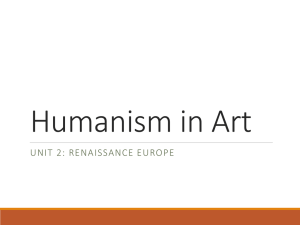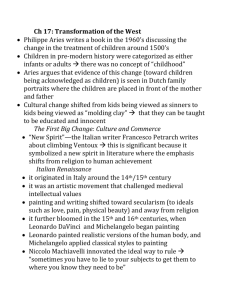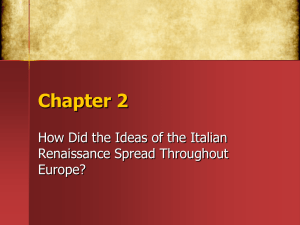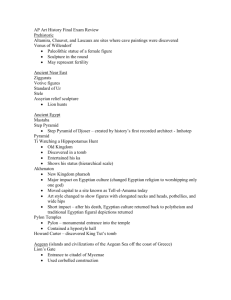Humanism and Art Article
advertisement
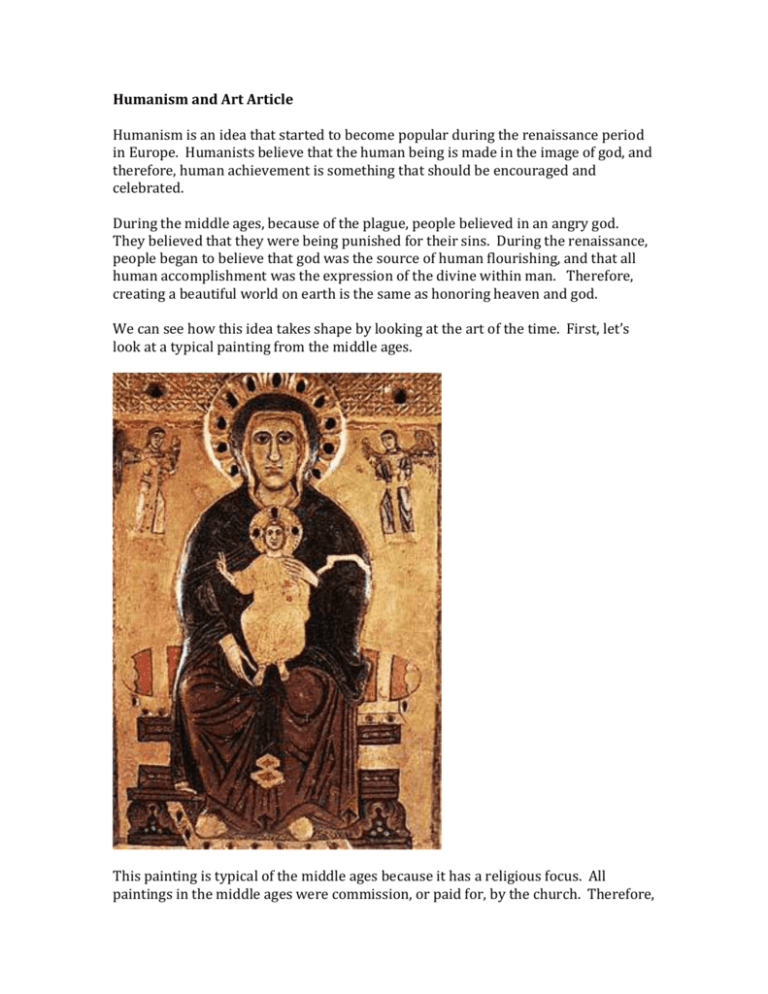
Humanism and Art Article Humanism is an idea that started to become popular during the renaissance period in Europe. Humanists believe that the human being is made in the image of god, and therefore, human achievement is something that should be encouraged and celebrated. During the middle ages, because of the plague, people believed in an angry god. They believed that they were being punished for their sins. During the renaissance, people began to believe that god was the source of human flourishing, and that all human accomplishment was the expression of the divine within man. Therefore, creating a beautiful world on earth is the same as honoring heaven and god. We can see how this idea takes shape by looking at the art of the time. First, let’s look at a typical painting from the middle ages. This painting is typical of the middle ages because it has a religious focus. All paintings in the middle ages were commission, or paid for, by the church. Therefore, all paintings were of religious scenes and saints. Saints were shown with halos, surrounded by gold, and with facial expressions that showed that they were beyond the human world. All of this began to change during the renaissance. “The Arnolfini Portait”, by Jan Van Eyck is of a noble couple. Nobles began to hire artists to paint their portraits. One reason why this happened is because nobles now had enough money to pay the artists for their services. Another reason for this is that, because of humanism, ordinary people were considered worthy subjects for a painting. You can also notice the attention to detail in Van Eyck’s painting. It is so detailed, that you can see the reflection of the artist painted in the mirror behind the couple. This is due to artists being free to get more training and practice during the renaissance period. Life was more secure, so there was more opportunity to learn and practice. In addition to regular people being painted for the first time, saints and other holy people were painted in the same way as normal people. In the middle ages saints would be painted with halos, but in renaissance paintings, this is absent. One example of this is DaVinci’s “Last Supper” Another thing we can see from the last supper is how renaissance artists used perspective. Paintings began to be made in a style that created an illusion of three dimensions. This was another way that renaissance artists were able to bring their subjects down to earth. Another example of perspective is seen in “The Lamentation Over the Dead Christ” by Mantegna. Here we can see Jesus painted as a human being rather than a divine figure immediately after being taken down from the cross. This isn’t meant to mean that Jesus is seen as less special than he was in the middle ages. Rather, it shows a change in perspective. Jesus isn’t special because he was beyond human. He is special because he is human. Divinity is in humanity itself. Petrarch is considered to be the founder of humanism. He is famous for going into ancient parts of cities in Italy and uncovering ancient roman and greek manuscripts. These manuscripts contained both greek and roman techniques for art and architecture and clues about greek and roman life and philosophy. The word “renaissance” is actually French for rebirth. What is being reborn? The culture of the ancient greeks and romans. During the middle ages, this culture was lost, and during the renaissance, it was rediscovered. Renaissance artists tried to learn as much as they could from their ancestors. Michaelangelo’s David sculpture, is one example of a renaissance sculpture that copies the Roman style. The first thing people notice is that David is nude. According to the Romans and Greeks, the human body was the most beautiful of god’s creations and therefore something to be celebrated and not something to be ashamed of. The second thing you notice about the David is that it is a very realistic representation of the human body. Renaissance artists worked very hard to learn how to accurately depict the human form. The more accurately they could depict the human form, the better their representation of God’s creation. Renaissance artists also often painted scenes and figures from Greek mythology. One of the most famous paintings is Botticelli’s The Birth of Venus. This painting shows Venus, the roman goddess of love, emerging from a seashell. Renaissance artists saw the Greek and roman gods and goddesses as representations of nature. Therefore painting these gods and goddesses was another way of honoring god’s creation. Looking at things from a humanist perspective, honoring and celebrating the beauty of the world we live in is just as important as heaven. God made the world for us and it is up to us to make it beautiful and appreciate its beauty. Humanists saw man and nature as profoundly interconnected. One cannot exist without the other. This is the meaning behind Giuseppe Arcimboldo’s “Vertumnus.” In this painting the artist paints a man made of vegetables, showing that we are all made up of the same stuff as nature. Another famous artist is Rafael. His work is another example of artists trying to capture the divine beauty within humanity. Rafael’s created many paintings of the Mary. We refer to these paintings as Rafael’s Madonnas. In these paintings, Rafael attempts to show the essential beauty of the human form. Perhaps the painting that best demonstrates the renaissance ideal of humanism is Michelangelo’s “Creation of Adam” that is painted on the ceiling of the Sistine chapel. In this painting Man is reaching out to god and at the same time god is reaching out to man. The idea is that without god, man is lost, and at the same time, without man, there is nobody to honor and praise god’s creation. Notice that god is making more of an effort to reach out than Adam. Perhaps Michaelangelo is saying that god’s need for man is stronger than our need for god. But perhaps he is just saying that man is lazy. The meaning of art is open to interpretation and it is important to discuss and listen to multiple interpretations. Finally, an article about renaissance art would not be complete without mentioning some of Leonardo DaVinci’s other works. Leonardo’s Vitruvian Man sketch shows the geometric perfection within the human form. By looking at the perfection of the geometry of man, one could see the perfection of his creator, in whose form he is made. His Mona Lisa is the most amazing example of attention to detail. It was the first painting to be made without sketching in pencil first. It is the most famous painting in the world and there is still a lot of mystery behind it. It is on display in France and not Italy. DaVinci was a good friend of the French king Francoise I and spend much time living in the French countryside. The painting was stolen once from the Louvre. You can read more about this in the book, Vanished Smile: The Theft of the Mona Lisa by R.A. Scotti. The main ideas of humanism are present in the great art of the renaissance period. We can see these values by looking at what the artists painted and how they painted these things. In this way, art is an important window into human culture and history. Your assignment for tonight is to choose one artist mentioned in the article above. Research this artists life and write a profile for the artist. The profile should include information about where and when the artist lived, his training, his major accomplishments, and the struggles he faced. A planning document is attached to this post.
